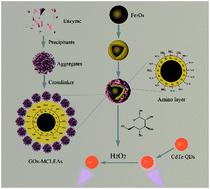当前位置:
X-MOL 学术
›
New J. Chem.
›
论文详情
Our official English website, www.x-mol.net, welcomes your
feedback! (Note: you will need to create a separate account there.)
Fluorescent biosensor based on magnetic cross-linking enzyme aggregates/CdTe quantum dots for the detection of H2O2-bioprecursors
New Journal of Chemistry ( IF 2.7 ) Pub Date : 2020-09-29 , DOI: 10.1039/d0nj03761c Guoning Chen 1, 2, 3, 4 , Qianqian Hu 1, 2, 3, 4 , Hua Shu 1, 2, 3, 4 , Lu Wang 1, 2, 3, 4 , Xia Cui 1, 2, 3, 4 , Jili Han 1, 2, 3, 4 , Kamran Bashir 1, 2, 3, 4 , Zhimin Luo 1, 2, 3, 4 , Chun Chang 1, 2, 3, 4 , Qiang Fu 1, 2, 3, 4
New Journal of Chemistry ( IF 2.7 ) Pub Date : 2020-09-29 , DOI: 10.1039/d0nj03761c Guoning Chen 1, 2, 3, 4 , Qianqian Hu 1, 2, 3, 4 , Hua Shu 1, 2, 3, 4 , Lu Wang 1, 2, 3, 4 , Xia Cui 1, 2, 3, 4 , Jili Han 1, 2, 3, 4 , Kamran Bashir 1, 2, 3, 4 , Zhimin Luo 1, 2, 3, 4 , Chun Chang 1, 2, 3, 4 , Qiang Fu 1, 2, 3, 4
Affiliation

|
The sensing method for hydrogen peroxide could also be employed to detect H2O2-bioprecursors in the presence of oxidase. However, the sensitivity of the conventional method is limited, and the catalytic stability and recyclability of enzymes also need to be improved. In this study, glucose was chosen as a typical representative H2O2-bioprecursor to design a fluorescence sensing system for H2O2-bioprecursors based on a magnetic immobilized enzyme and CdTe quantum dots. The magnetic immobilized enzyme was fabricated by a cross-linking method to enhance the stability and recyclability of the enzyme. The obtained product was characterized by scanning electron microscopy, transmission electron microscopy, energy dispersive spectrometry, and vibrating sample magnetometry, respectively. The CdTe quantum dots were prepared by a hydrothermal method, and revealed a maximum emission peak at about 610 nm under the maximum excitation light (339 nm). The developed CdTe QDs exhibited excellent sensing performance for hydrogen peroxide. The prepared immobilized enzyme and quantum dots were used to develop a fluorescence sensing system and were successfully exploited to detect a typical H2O2-bioprecursor (glucose) in the presence of glucose oxidase. The method exhibited good linear performance in the concentration range of 1–20 μg mL−1, and good recoveries ranging from 106.2–117.7%. This study demonstrated that the strategy could be extended to detect more H2O2-bioprecursors.
中文翻译:

基于磁性交联酶聚集体/ CdTe量子点的荧光生物传感器,用于检测H2O2-生物前体
过氧化氢的感测方法也可用于在氧化酶存在下检测H 2 O 2-生物前体。然而,常规方法的灵敏度是有限的,并且还需要提高酶的催化稳定性和可回收性。在这项研究中,葡萄糖被选为典型代表ħ 2 ö 2 -bioprecursor设计一个荧光检测系统用于h 2 ö 2-基于磁性固定酶和CdTe量子点的生物前体。通过交联方法制备磁性固定酶以增强酶的稳定性和可回收性。所获得的产物分别通过扫描电子显微镜,透射电子显微镜,能量色散光谱法和振动样品磁力法进行表征。通过水热法制备CdTe量子点,并在最大激发光(339nm)下在约610nm处显示最大发射峰。研发的CdTe量子点对过氧化氢具有出色的感测性能。制备的固定化酶和量子点被用于开发荧光传感系统,并成功地用于检测典型的H 2 O 2-在葡萄糖氧化酶存在下的生物前体(葡萄糖)。该方法在浓度范围为1–20μgmL -1时表现出良好的线性性能,回收率在106.2–117.7%之间。这项研究表明该策略可以扩展以检测更多的H 2 O 2-生物前体。
更新日期:2020-10-15
中文翻译:

基于磁性交联酶聚集体/ CdTe量子点的荧光生物传感器,用于检测H2O2-生物前体
过氧化氢的感测方法也可用于在氧化酶存在下检测H 2 O 2-生物前体。然而,常规方法的灵敏度是有限的,并且还需要提高酶的催化稳定性和可回收性。在这项研究中,葡萄糖被选为典型代表ħ 2 ö 2 -bioprecursor设计一个荧光检测系统用于h 2 ö 2-基于磁性固定酶和CdTe量子点的生物前体。通过交联方法制备磁性固定酶以增强酶的稳定性和可回收性。所获得的产物分别通过扫描电子显微镜,透射电子显微镜,能量色散光谱法和振动样品磁力法进行表征。通过水热法制备CdTe量子点,并在最大激发光(339nm)下在约610nm处显示最大发射峰。研发的CdTe量子点对过氧化氢具有出色的感测性能。制备的固定化酶和量子点被用于开发荧光传感系统,并成功地用于检测典型的H 2 O 2-在葡萄糖氧化酶存在下的生物前体(葡萄糖)。该方法在浓度范围为1–20μgmL -1时表现出良好的线性性能,回收率在106.2–117.7%之间。这项研究表明该策略可以扩展以检测更多的H 2 O 2-生物前体。











































 京公网安备 11010802027423号
京公网安备 11010802027423号